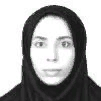
Ateke Goshvarpour
Work place: Computational Neuroscience Laboratory, Department of Biomedical Engineering, Faculty of Electrical Engineering, Sahand University of Technology, Tabriz, Iran
E-mail: ak_goshvarpour@sut.ac.ir
Website:
Research Interests: Mathematical Analysis, Solid Modeling, Neural Networks
Biography
Ateke Goshvarpour, Obtained a Masters in Biomedical Engineering from Islamic Azad University, Mashhad Branch, Iran in 2010. She is a Ph.D. student at Sahand University of Technology, Tabriz, Iran. Her research interests include biomedical signal processing, mathematical modeling, nonlinear analysis and neural networks.
Author Articles
Modeling Epileptic EEG Time Series by State Space Model and Kalman Filtering Algorithm
By Atefeh Goshvarpour Ateke Goshvarpour Mousa Shamsi
DOI: https://doi.org/10.5815/ijisa.2014.03.03, Pub. Date: 8 Feb. 2014
The human brain is one of the most complex physiological systems. Therefore, electroencephalogram (EEG) signal modeling is important to achieve a better understanding of the physical mechanisms generating these signals. The aim of this study is to investigate the application of Kalman filter and the state space model for estimation of electroencephalogram signals in a specific pathological state. For this purpose, two types of EEG signals (normal and partial epilepsy) were analyzed. The estimation performance of the proposed method on EEG signals is evaluated using the root mean square (RMS) measurement. The result of the present study shows that this model is appropriate for the analysis of EEG recordings. In fact, this model is capable of predicting changes in EEG time series with phenomena such as epileptic spikes and seizures.
[...] Read more.Nonlinear Evaluation of Electroencephalogram Signals in Different Sleep Stages in Apnea Episodes
By Atefeh Goshvarpour Ataollah Abbasi Ateke Goshvarpour
DOI: https://doi.org/10.5815/ijisa.2013.10.09, Pub. Date: 8 Sep. 2013
Distinct sleep phases are related to different dynamical patterns in electroencephalogram (EEG) signals. In this article, the relationship between the sleep stages and nonlinear behavior of sleep EEG is explored. In particular, analysis of approximate entropy (ApEn) and the largest Lyapunov exponent is evaluated in patients with sleep apnea, which is defined as respiratory flow that is suspended or decreased for more than 10 s. The pathological sleep EEG signals for analysis were obtained from the MIT-BIH polysomnography database available online at the PhysioBank. The results show that for the both normal and apneic sleep epochs, ApEn decreased significantly as the sleep goes into deeper stages. Therefore, it indicated that as sleep becomes deeper, the brain function becomes less activated. Compared with normal sleep, the mean value of largest lyapunov exponents was also significantly lower than that of normal epochs during deep sleep stages. The results also show that the average largest lyapunov exponents of EEG signals increased in the REM state. Because during this stage of sleep, the cortex becomes more active and more neurons incorporate in the information processing. In conclusion, the nonlinear dynamical measures obtained from the nonlinear dynamical analysis such as the approximate entropy and largest lyapunov exponents can be useful for characterizing the physiological or pathological states of the brain.
[...] Read more.Shape Classification Based on Normalized Distance and Angle Histograms Using PNN
By Atefeh Goshvarpour Hossein Ebrahimnezhad Ateke Goshvarpour
DOI: https://doi.org/10.5815/ijitcs.2013.09.06, Pub. Date: 8 Aug. 2013
This study presents an attempt to develop a reliable computerized algorithm, which could classify images into predetermined classes. For this purpose, the histogram of the normalized distance between each two points of the image (algorithm I) and the histogram of normalized distances between three points and the normalized angle of the image edge points (algorithm II) are analyzed. The probabilistic neural network (PNN) is implemented to do shape classification. Our proposed approach is tested on ten classes of MPEG-7 image database. It has been shown that feature extraction based on the distance histogram (algorithm I and algorithm II) is efficient due to its potential to preserve interclass and intra-class variation. In addition, these algorithms ensur invariance to geometric transformations (e.g. translation, rotation and scaling). The best classification accuracy is achieved by eight classes with the total accuracy of 90% and 92.5% for algorithm I and algorithm II, respectively. The reported experiment reveal that the proposed classification algorithm could be useful in the study of MPEG-7 shapes.
[...] Read more.Classification of Epileptic EEG Signals using Time-Delay Neural Networks and Probabilistic Neural Networks
By Ateke Goshvarpour Hossein Ebrahimnezhad Atefeh Goshvarpour
DOI: https://doi.org/10.5815/ijieeb.2013.01.07, Pub. Date: 8 May 2013
The aim of this paper is to investigate the performance of time delay neural networks (TDNNs) and the probabilistic neural networks (PNNs) trained with nonlinear features (Lyapunov exponents and Entropy) on electroencephalogram signals (EEG) in a specific pathological state. For this purpose, two types of EEG signals (normal and partial epilepsy) are analyzed. To evaluate the performance of the classifiers, mean square error (MSE) and elapsed time of each classifier are examined. The results show that TDNN with 12 neurons in hidden layer result in a lower MSE with the training time of about 19.69 second. According to the results, when the sigma values are lower than 0.56, the best performance in the proposed probabilistic neural network structure is achieved. The results of present study show that applying the nonlinear features to train these networks can serve as useful tool in classifying of the EEG signals.
[...] Read more.Other Articles
Subscribe to receive issue release notifications and newsletters from MECS Press journals